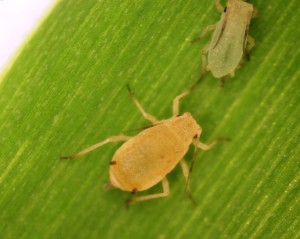Be on the Lookout for White Sugarcane Aphid in Sorghum
go.ncsu.edu/readext?321887
en Español / em Português
El inglés es el idioma de control de esta página. En la medida en que haya algún conflicto entre la traducción al inglés y la traducción, el inglés prevalece.
Al hacer clic en el enlace de traducción se activa un servicio de traducción gratuito para convertir la página al español. Al igual que con cualquier traducción por Internet, la conversión no es sensible al contexto y puede que no traduzca el texto en su significado original. NC State Extension no garantiza la exactitud del texto traducido. Por favor, tenga en cuenta que algunas aplicaciones y/o servicios pueden no funcionar como se espera cuando se traducen.
Português
Inglês é o idioma de controle desta página. Na medida que haja algum conflito entre o texto original em Inglês e a tradução, o Inglês prevalece.
Ao clicar no link de tradução, um serviço gratuito de tradução será ativado para converter a página para o Português. Como em qualquer tradução pela internet, a conversão não é sensivel ao contexto e pode não ocorrer a tradução para o significado orginal. O serviço de Extensão da Carolina do Norte (NC State Extension) não garante a exatidão do texto traduzido. Por favor, observe que algumas funções ou serviços podem não funcionar como esperado após a tradução.
English
English is the controlling language of this page. To the extent there is any conflict between the English text and the translation, English controls.
Clicking on the translation link activates a free translation service to convert the page to Spanish. As with any Internet translation, the conversion is not context-sensitive and may not translate the text to its original meaning. NC State Extension does not guarantee the accuracy of the translated text. Please note that some applications and/or services may not function as expected when translated.
Collapse ▲White sugarcane aphid was found last week in South Carolina sorghum and this week as far north as Florence. This insect is threatening sorghum production in Texas and the mid-South. We need to be on the lookout in North Carolina all the way through harvest to determine if this insect is here. Note that there are many native aphid pests of sorghum so it is important to know what you might be fighting. Please read on for information on identification and management.
The white sugarcane aphid recently made a host switch to sorghum. This new behavior has caught everyone off guard and has the potential to hit us in North Carolina. Why is this insect so bad? Before sorghum heads it can kill or stunt plants, prevent heading, or reduce head size. After sorghum heads up until harvest, it can prevent equipment from harvesting by plugging it with honeydew (from the aphids). This insect breeds extremely rapidly. Once you have the insect, it can blow up in a few days. Weekly sampling intervals need to be shortened for proper management. Finally, it is very difficult to manage with registered insecticides. The only effective registered insecticide we have in North Carolina is Lorsban, which has a 60 day pre-harvest interval restriction. Other states have applied for a Section 18 exemption to register Transform. Until we detect the insect in our state, we will not have this option.
White sugarcane aphids are yellow and can be distinguished from other aphids in sorghum by the presence of black tailpipes on the tail (cornicles) and black feet below their yellow legs. These aphids will often infest entire fields, which is rare for our native aphids and are especially a problem behind sprays for other insects that might kill beneficial insects. Please report any aphids fitting this description to NCCE as soon as possible.



